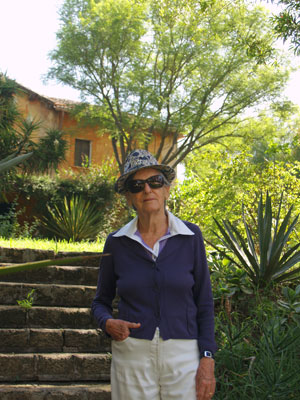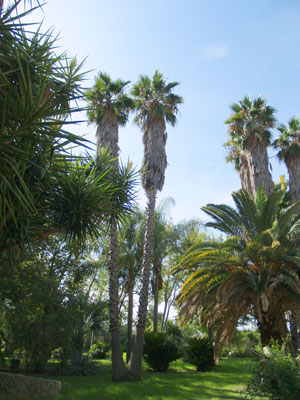Il Biviere in Sicily
This item appears on page 65 of the April 2011 issue.
Sicily presented a problem. Searching through guidebooks, I could not find a “Garden Path” garden to visit. With that, I wrote to the Italian Government Tourist Board (630 Fifth Ave., Ste. 1565, New York, NY 10111; 212/245-5618), giving them a list of Sicilian ports I’d be visiting in early fall of 2010 while on board Sea Cloud, the 1930s-built plaything of heiress Marjorie Merriweather Post.
An e-mail message came flying back: ‘From Syracuse, make your way to Il Biviere.’
Turning to the Internet, I found contact information. Yes, I would be welcome at the garden as a guest. A driver, at my expense, would meet me at the dock.
Delving the Internet deeper, I read of a garden with mythological beginnings involving Hercules, the harvest goddess Ceres and the skin of the Nemean Lion that, in the complicated way of myths, led to the creation of a lake: Lacunus Erculeus.
I learned that when Sicily was under Arab rule, AD 832-1060, the lake was known as Il Biviere, meaning “watering place for animals.” So abundant was Il Biviere in flora and fauna that for centuries to come it was favored grounds for sportsmen — until the 1930s. Fear of malaria led to the draining of the lake. Lushness gradually became an eyesore of dust and rocks.
In 1968, Principe Scipione Borghese and his wife, Principessa Maria Carla Borghese, owners of Il Biviere by order of a 1392 feudal edict, decided to farm citrus on the land. That decision somehow metamorphosed into a renowned Mediterranean garden. I had to go see.
As promised, a car awaited at the dock. Leaving Syracuse behind, we entered an unpromising landscape of industry and neglected agriculture. Turning off the main highway, we crossed a small bridge over the reed-choked Lentini River to pause at a solid green gate centering a bougainvillea-draped wall.
The gate slowly opened, revealing an oasis in every shade of green. Passing a small chapel edged in a flurry of blue plumbago, we pulled into the graveled parking area of a Mediterranean-style mansion.
Principessa Maria Carla Borghese — a tall woman of elegant bearing that my arithmetic told me was entering her eighth decade — greeted me dressed in white jeans and a casual sweater. I asked if she might tell me about the garden’s beginnings before we explored the garden’s acreage.
“The decision to move here completely changed our lives,” she said of their 1968 plan to transform Il Biviere into productiveness. (From my reading, I knew of the death of Principe Scipione Borghese in 2001.)
She continued: “How could we and our four children live in this terrible place, the house in disrepair and all around rocks and dust?! I had a decision to make. Either I could continue being depressed or roll up my sleeves and try to turn this terrible spot into a place to live.”
She began to imagine a garden with all kinds of trees, flowering bushes, vines — “a garden that wasn’t,” as she described it. “Where to begin? Then, an idea! I could give the long jetties of the ancient port a new reason to exist.”
Filling the rock jetties with soil was easy, but what to plant?
“I’d no gardening experience, and we couldn’t afford a landscape architect,” she said. “I haunted nurseries and private gardens and became fascinated with succulents. Such variety! Tall and slender, short and round, thorny, trailing — and yet undemanding of care.”
In June of 1969, a gift gave impetus to the garden.
“A lorry of plants selected by the gardener of Palermo’s Villa Trabia came to the gate carrying unusual specimens from faraway countries,” she said. “Young elms, small Phoenix canariensis, lovely boulevard palms. The gift began this oasis.”
Then it was time to stroll the garden. I was introduced to the Parkinsonia aculeata, its presence in the garden due to a visit to Greece in 1980.
“I became enchanted with the tree’s feathery leaves, yellow flowers, jasmine-like scent,” she recalled. “I gathered some seeds. In the spring I had a lovely seedling. Look at it now!”
A towering palm near the swimming pool — “Washingtonia robusta, origin California,” she said. “A friend brought it in a terra-cotta pot when she came for lunch in 1978.”
Progeny of that Washingtonia robusta today dramatically punctuate the garden.
We walked the planted jetties to admire the diversity of the succulents that has made Il Biviere well known to collectors, continuing on through varieties of cactus, agave, aloe, roses in a variety of shades, olive trees — on it went, with the principessa providing the botanical name and stories about each along the way.
There were stories other than horticultural to be told: “In March of 1988, a phone call came from a gracious man wanting to know if we’d be willing to receive the Queen Mother, who would like to visit our garden. I was speechless!
“She came in June with her entourage. We lunched together and walked the garden, she dressed in light blue head to toe and carrying a white parasol.”
The Queen Mother was the first of hundreds drawn to Il Biviere, including art critics, film directors, landscape architects and many who, just like me, simply love gardens.
It was time for me to leave, if I were not to miss Sea Cloud’s departure from Syracuse. As we drove through the gate, I asked if we could stop so that I might take a last look back at the lush landscape evolved from princess Maria Carla Borghese’s “garden that wasn’t.”
Groups of two to 40 are welcome to visit the garden. €10 (near $13.50) per person. Multicourse lunch with wine, €90; brunch, €60, and tea, €30. Guided garden visit with Principessa Maria Carla Borghese included. Reserve at least two weeks in advance. Best time to visit is mid-March to November.
It is also possible to stay at Il Biviere. The three-bedroom La Casina del Biviere is available by the week for no more than six persons. Price to be agreed upon.
Contact Il Biviere (Contrada Case Biviere, Villa Borghese, Lentini [SR], Sicily 96016, Italy; phone +39 095 783 1449, fax 783 5575, e-mail biviere@sicilyonline.it).


